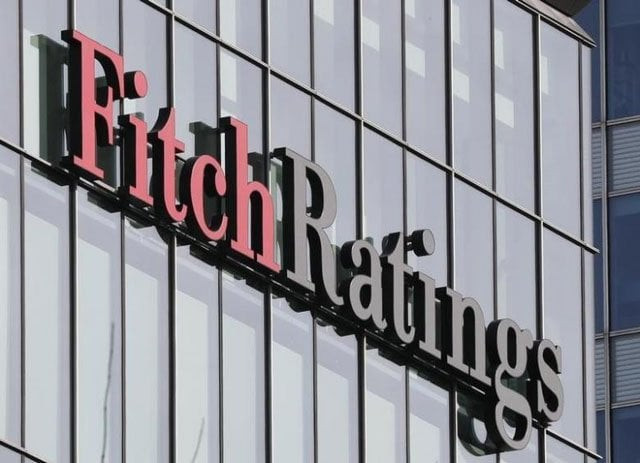Fitch keeps Pakistan’s rating stable at ‘B negative’
IMF board decides to take up country’s request for $6b loan on July 3 for decision

PHOTO: REUTERS
The development came as the IMF Executive Board decided to take up Pakistan’s request for the $6-billion loan programme on July 3 for decision.
Fitch, one of the three big global credit rating agencies, has estimated that Pakistan’s debt-to-GDP ratio will jump to 77% or Rs34 trillion by the end of next fiscal year - a cumulative addition of nearly Rs10 trillion in just two years of Prime Minister Imran Khan’s government.
Fitch Ratings forecast that it would be challenging for the Federal Board of Revenue (FBR) to meet its Rs5.55-trillion tax collection target and there was a likelihood that the government would have to cut its expenditure in the next fiscal year to meet the 0.6% primary deficit target.
Fitch on Friday affirmed Pakistan’s “B negative” rating with a stable outlook against expectations of an improvement due to finalisation of the bailout package between Pakistan and the IMF.
Sources in the Ministry of Finance told The Express Tribune that there was a likelihood that the IMF Executive Board may take up Pakistan’s case on July 3.
Pakistan's tough decisions on economy to pay dividends: Fitch
But the international rating agency said Pakistan’s ratings reflected the challenging external finances and low reserve coverage, high public debt and weak governance indicators.
It stated that Pakistan’s rating was constrained by structural weaknesses in its development and governance indicators. Its per capita is well below the median of ‘B’-rated peers. Governance quality is also low as its World Bank governance indicator score is in the 23rd percentile, compared with the ‘B’ median 38th percentile.
“Recent policy actions, including an agreement with the IMF staff on a forthcoming programme, should ease external finance risks, but reserve levels will take time to rise and the programme will face significant implementation risks,” it said.
The rating agency said reforms could prove politically challenging to implement and risks around compliance with IMF targets were underscored by the irregular adherence to past programmes.
It said the fiscal deficit would remain high at 7.1% of gross domestic product (GDP) by the end of next fiscal year. “Meeting revenue targets in the context of sluggish growth could prove challenging, but the government is likely to lower expenditure relative to the budget to meet the primary deficit target,” it added.
Fitch said fiscal performance at the provincial level was also a downside risk to the outlook and improved fiscal coordination with the provinces was important to consolidation efforts.
Fitch hoped that the $6-billion staff-level agreement would reduce external financing pressures and facilitate the rebuilding of reserve buffers. However, it said, factors that could lead to a negative rating action were Pakistan’s inability to mobilise sufficient external funding to ease financing strains through an IMF programme or other forms of bilateral assistance.
The main factors that could, individually or collectively, lead to a positive rating action are implementation of an effective policy stance, sufficient to address external imbalances, and facilitate a rebuilding of foreign exchange reserves.
Fitch expected external debt repayments to remain high over the medium term. It has projected sovereign external debt service alone to be around $8 billion to $9 billion per annum in coming years, particularly in light of the recent large upswing in external borrowing.
Pakistan to focus more on supporting growth: Fitch
In addition, repayments related to loans under the China-Pakistan Economic Corridor (CPEC) are set to pick up in early 2020.
Fitch forecast reserves would begin rising during FY20 on the back of improved access to external financing. Liquid foreign exchange reserves were still low, at $7.8 billion, sufficient for only 1.7 months of import coverage, as of June 3.
This is despite the fact that the country received $7.2 billion from Saudi Arabia, the United Arab Emirates and China since last November.
It forecast that the current account deficit would narrow down to 3% of GDP in the fiscal year ending June 2020, largely through import compression.
The rating agency said budget expenditure would rise on higher interest payments and government plans to support social and development spending to offset the negative effects of macroeconomic adjustment.
In its agreement with IMF staff, the authorities committed to achieving a primary deficit of 0.6% of GDP in FY20, which entails an estimated 1.6% of GDP consolidation in the primary deficit relative to the outgoing fiscal year.
It also projected 3.5% economic growth for the next fiscal year, which was higher than the finance ministry’s own estimate of 2.4% growth in fiscal year 2019-20.
It added that inflation was set to remain high at 9% on the back of past rupee depreciation and tax and energy tariff increases, which was lower than the finance ministry’s estimate of 13%.
Published in The Express Tribune, June 15th, 2019.
Like Business on Facebook, follow @TribuneBiz on Twitter to stay informed and join in the conversation.



















COMMENTS
Comments are moderated and generally will be posted if they are on-topic and not abusive.
For more information, please see our Comments FAQ